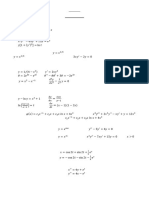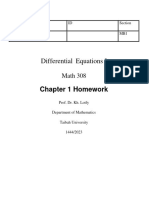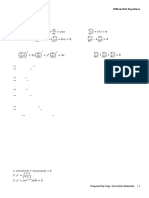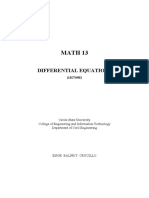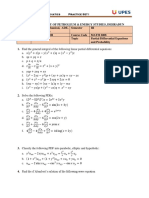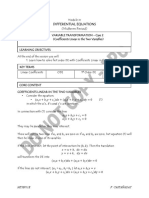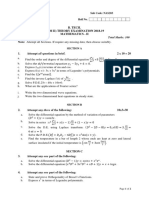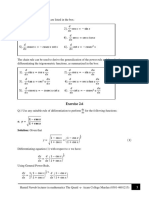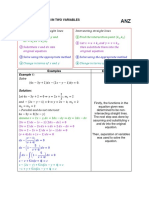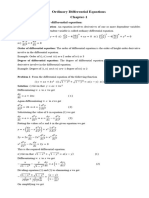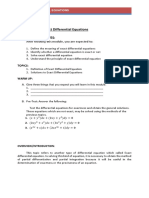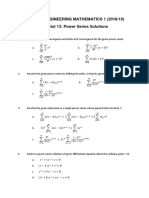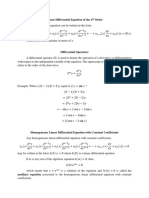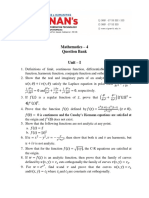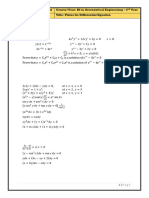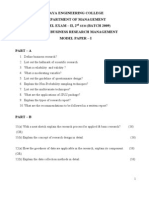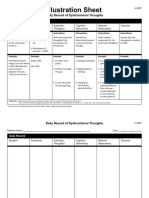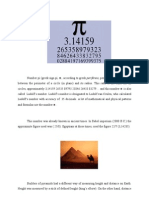CE 27 11617 Practice Problems For Second LE
CE 27 11617 Practice Problems For Second LE
Uploaded by
CJCopyright:
Available Formats
CE 27 11617 Practice Problems For Second LE
CE 27 11617 Practice Problems For Second LE
Uploaded by
CJOriginal Description:
Original Title
Copyright
Available Formats
Share this document
Did you find this document useful?
Is this content inappropriate?
Copyright:
Available Formats
CE 27 11617 Practice Problems For Second LE
CE 27 11617 Practice Problems For Second LE
Uploaded by
CJCopyright:
Available Formats
CE 27 (Analytical and Computational Methods in Civil Engineering II)
Practice Problem for Third Long Examination
First Semester AY 2016-2017
Directions: Read and understand the problems given below. Provide ALL the necessary calculations and
assumptions for the problems. Write them in a blue book and submit the HARD COPY of your answers on or
before October 22, 2016 (Saturday).
1. Find the solution to the following ordinary differential equations.
1
a. 2 + ( 2 + 3 + ) = 0
b. + tan = sec + cos , (0) = 1
1
c. (2 tan + 5) + ( 2 sec 2 ) = 0 , (2) = 4
d. = 3 1/3
3 + 2 +3 3
e. = 3
+3 2
11
Ans: () ( 3 + 1) + = 0; () = sin + ( + 1) cos ; () 2 tan + 5 4
= 0;
2 2 1 3
() 3 = 3 (4 3 + 18 2 + 54 + 81); () + 3 = ln|| +
4
2. A tank with a capacity of 500 gal originally contains 200 gal of water with 100 lb of salt in solution.
Water containing 1 lb of salt per gallon is entering at a rate of 3 gal/min, and the mixture is allowed to
flow out of the tank at a rate of 2 gal/min.
a. Find the amount of salt in the tank at any time prior to the instant when the solution begins to
overflow.
b. Find the concentration (in pounds per gallon) of salt in the tank when it is on the point of
overflowing.
100(200)2 2003 121
Ans: () () = + 200 + (+200)2
< 300; () 125 /
3. Two curves are said to be orthogonal at a point of intersection (, ) if they have perpendicular
tangents at (, ). In other words, their tangents are negative reciprocal of each other. Solve the
orthogonal trajectories (i.e. family of curves that are orthogonal to the given family of curves) of these
family of curves:
a. 2 + 4 + 2 =
2
b. =
1
Ans: () ( )3 ( + ) = ; () 2 = 2 ln(1 + 2 2 ) +
4. An initial value problem is given as:
" + = , () = () = (1)
Find the value of y at x = 1.0. Use ONLY the Method of Undetermined Coefficients (MUC) to determine
the particular solution, yP.
Ans: (1) = 2 = 5.43656
5. A second order ordinary differential equation is shown:
" = + (2)
Find the primitive (general) solution of the given differential equation. Use ONLY the Method of Variation
of Parameters (MVP) to determine the particular solution, xP.
1
Ans: () = 1 + 2 +
2
mplumbera 1-15-16 Page 1 of 2
CE 27 (Analytical and Computational Methods in Civil Engineering II)
Practice Problem for Third Long Examination
First Semester AY 2016-2017
6. A force of 10 Newtons can stretch a spring by 0.04 m. Suppose a mass of 5 kg is attached to the lower
end of the spring. We stretch the mass downward by 0.05 m from its equilibrium position and release it
from rest. Determine the position of the mass relative to its equilibrium position at t = 0.5 seconds for
the following conditions:
a. Assume no damping
b. Which of the following oscillating functions must be avoided to get rid of resonance condition?
Justify your answer.
{10cos 5t, -6cos 7.07t, 2.5etcos 7.07t}
c. Assume that the mass is moving in a medium having a damping force of 40 Newton when the
velocity of the mass is 2 meter/sec. Set up the differential equation describing the position of
the mass at any time t. Solve the differential equation, find x(0.5) and compare the results with
the output coming from the formula presented in class (i.e. consistent with the case of this
problem).
Ans: ()(0.5) = 0.01763 ; ()(0.5) = 0.0196
mplumbera 1-15-16 Page 2 of 2
You might also like
- 12-MODULE-3!03!09-2019 (03-Sep-2019) Material III 03-Sep-2019 Module 3.2 Linear Differential EquationDocument7 pages12-MODULE-3!03!09-2019 (03-Sep-2019) Material III 03-Sep-2019 Module 3.2 Linear Differential EquationParth VijayNo ratings yet
- chapter 1 homeworkDocument2 pageschapter 1 homeworkmohamed hakeemNo ratings yet
- 11 Ec Uuuuuu UuuuuuDocument5 pages11 Ec Uuuuuu UuuuuuvaleriaNo ratings yet
- UE23MA141A - Unit 3 and 4 CWDocument9 pagesUE23MA141A - Unit 3 and 4 CWiammusharraf11No ratings yet
- Differential Equations 308 Chapter 1 HomeworkDocument9 pagesDifferential Equations 308 Chapter 1 HomeworkAbd El Rahman Sayd AliNo ratings yet
- Vidya Jyothi Institute of Technology M-Ii Question Bank Unit-I: Short QuestionsDocument10 pagesVidya Jyothi Institute of Technology M-Ii Question Bank Unit-I: Short Questionsrajeev_kumar365No ratings yet
- Differential EquationsDocument3 pagesDifferential EquationsKeith AndulanNo ratings yet
- Higher Order DEs PDFDocument24 pagesHigher Order DEs PDFTushar GholapNo ratings yet
- Efdhv JH JD JHBFDocument2 pagesEfdhv JH JD JHBFananthu.uNo ratings yet
- Assignment 3Document1 pageAssignment 3Yogesh GargNo ratings yet
- 4.6: Homogeneous Linear Equations With Constant CoefficientsDocument4 pages4.6: Homogeneous Linear Equations With Constant Coefficientsfarah.ab171No ratings yet
- Math 13: Differential EquationsDocument11 pagesMath 13: Differential EquationsReyzhel Mae MatienzoNo ratings yet
- Engineering Analysis: Faculty of Engineering Petroleum EngineeringDocument7 pagesEngineering Analysis: Faculty of Engineering Petroleum EngineeringNazeer AlyasNo ratings yet
- Engineering Analysis: Faculty of Engineering Petroleum EngineeringDocument7 pagesEngineering Analysis: Faculty of Engineering Petroleum EngineeringNasih AhmadNo ratings yet
- Session 10: Ordinary Differential Equation: Second-Order Linear Differential EquationsDocument14 pagesSession 10: Ordinary Differential Equation: Second-Order Linear Differential EquationsAdamNo ratings yet
- EM 1 TRIAL EXAM September 2018Document4 pagesEM 1 TRIAL EXAM September 2018NurelynaNo ratings yet
- Updated Unit 4 - FODEDocument12 pagesUpdated Unit 4 - FODEvivocem863No ratings yet
- Exam Review QuestionsDocument2 pagesExam Review QuestionsLoje LabNo ratings yet
- Luau#7 ReviewDocument9 pagesLuau#7 ReviewSunil SutharNo ratings yet
- Engineering Analysis: Faculty of Engineering Petroleum EngineeringDocument7 pagesEngineering Analysis: Faculty of Engineering Petroleum EngineeringNazeer AlyasNo ratings yet
- Practice Set-I MATH 2008 PDFDocument4 pagesPractice Set-I MATH 2008 PDFRaj PratyushNo ratings yet
- MTHN31E - Module - 6 - Coefficients Linear in Two VariablesDocument5 pagesMTHN31E - Module - 6 - Coefficients Linear in Two VariablesrodNo ratings yet
- 09-25 Problem SetDocument2 pages09-25 Problem SetsonjabottlelawNo ratings yet
- 36601Document1 page36601arjunreddy14102002No ratings yet
- UNIT-3 Functions of Several VariablesDocument36 pagesUNIT-3 Functions of Several VariablesSujith.VetriMaaranNo ratings yet
- 111-1 Differential Equation FinalExamDocument2 pages111-1 Differential Equation FinalExamchienhsu1222No ratings yet
- Calculus II 2020-2021 S1 Midterm 3Document4 pagesCalculus II 2020-2021 S1 Midterm 3Frank WanNo ratings yet
- Assignment 4Document2 pagesAssignment 4snehilgamit04No ratings yet
- 15a54101052018 PDFDocument1 page15a54101052018 PDFVasuNo ratings yet
- PDE 3 - ME (3rd Sem)Document8 pagesPDE 3 - ME (3rd Sem)Nysa NanoNo ratings yet
- 2.2 The Derivative FunctionDocument16 pages2.2 The Derivative FunctionlegoNo ratings yet
- AssignmentDocument8 pagesAssignmentmohammed hamzaNo ratings yet
- Chapter 3 ODEDocument29 pagesChapter 3 ODEsamblackkillNo ratings yet
- NAMAL College, Mianwali (An Affiliated College of University of Engineering & Technology, Lahore)Document2 pagesNAMAL College, Mianwali (An Affiliated College of University of Engineering & Technology, Lahore)Saeed ShahNo ratings yet
- The General Linear EquationDocument13 pagesThe General Linear EquationJm AlipioNo ratings yet
- Question On Differential EquationsDocument3 pagesQuestion On Differential Equationstanmayrawat2005No ratings yet
- Maths2 Aktu QP NAS-203 Carry Over 2018-19Document2 pagesMaths2 Aktu QP NAS-203 Carry Over 2018-19Akanksha ChoudharyNo ratings yet
- CBCS B.Sc. (Mathematical Sciences) / B.Sc. (Physical Sciences) / B.Sc. (Life Sciences) /applied Sciences: 42357501: DSC-Differential EquationsDocument2 pagesCBCS B.Sc. (Mathematical Sciences) / B.Sc. (Physical Sciences) / B.Sc. (Life Sciences) /applied Sciences: 42357501: DSC-Differential Equations4068Bhavesh MalhotraNo ratings yet
- Exercise 2.6: Solution: Given ThatDocument10 pagesExercise 2.6: Solution: Given ThatSudais AkbarNo ratings yet
- Differential Equation - Examples of Coefficients Linear in Two VariablesDocument5 pagesDifferential Equation - Examples of Coefficients Linear in Two VariablesAimi Najwa ZailanNo ratings yet
- First Order Ordinary Differentiation EquationsDocument25 pagesFirst Order Ordinary Differentiation EquationsTanim AhmedNo ratings yet
- MODULE TITLE: Exact Differential Equations Learning ObjectivesDocument5 pagesMODULE TITLE: Exact Differential Equations Learning ObjectiveskjNo ratings yet
- LDE Part 1 of 8 CFDocument12 pagesLDE Part 1 of 8 CFKalyaniNo ratings yet
- Tutorial 13 Power SeriesDocument2 pagesTutorial 13 Power SeriesSafayet AzizNo ratings yet
- Paper I - EnglishDocument3 pagesPaper I - EnglishHarshanaNuwanNo ratings yet
- Lecture 3Document9 pagesLecture 3owronrawan74No ratings yet
- Lectures 04 PDFDocument7 pagesLectures 04 PDFNazeer AlyasNo ratings yet
- The General Linear EquationDocument13 pagesThe General Linear EquationJm AlipioNo ratings yet
- Vector Analysis Credentail InfoDocument15 pagesVector Analysis Credentail InfoSushanth ReddyNo ratings yet
- Chapter Two - 2Document17 pagesChapter Two - 2مسلم محمودNo ratings yet
- Diff Equa Sem5 Pyq-1Document2 pagesDiff Equa Sem5 Pyq-1Parth GuptaNo ratings yet
- De Chapter 15Document6 pagesDe Chapter 15Dracov PendonNo ratings yet
- Differential Equations:: Cagayan State University-Carig CampusDocument5 pagesDifferential Equations:: Cagayan State University-Carig CampusJulia Macugay100% (1)
- Maths S4&S5-1Document24 pagesMaths S4&S5-1gisubizobonheur544No ratings yet
- Unit - 4 - Differential EquationsDocument12 pagesUnit - 4 - Differential Equationsvijayhero7777No ratings yet
- M 4 Question BankDocument13 pagesM 4 Question BankDinesh PalavalasaNo ratings yet
- Deferential EquationDocument1 pageDeferential EquationBryl KitNo ratings yet
- Green Theorem QuestionDocument20 pagesGreen Theorem QuestionBarnedNo ratings yet
- Trigonometric Ratios to Transformations (Trigonometry) Mathematics E-Book For Public ExamsFrom EverandTrigonometric Ratios to Transformations (Trigonometry) Mathematics E-Book For Public ExamsRating: 5 out of 5 stars5/5 (1)
- Discovery Chapter 1 Her Choice, A Clannad Fanfic FanFictionDocument18 pagesDiscovery Chapter 1 Her Choice, A Clannad Fanfic FanFictionRiss EdullantesNo ratings yet
- How Walt Disney Evolved Under Dennis Hightower's Leadership Business ArticlesDocument12 pagesHow Walt Disney Evolved Under Dennis Hightower's Leadership Business ArticlesHamzah B ShakeelNo ratings yet
- Lesson Plan EnglishDocument5 pagesLesson Plan EnglishSelle TonezaNo ratings yet
- Blue Lined Climate Change Environment InfographicDocument1 pageBlue Lined Climate Change Environment InfographicCalvin YusopNo ratings yet
- Adaptive Theory-Based Improved Linear Sinusoidal Tracer Control Algorithm For DSTATCOMDocument11 pagesAdaptive Theory-Based Improved Linear Sinusoidal Tracer Control Algorithm For DSTATCOMAmmuRaNo ratings yet
- Book of ConcordDocument742 pagesBook of ConcordKawan de MatosNo ratings yet
- MIDTERMSDocument9 pagesMIDTERMSMichael T. SebullenNo ratings yet
- Bhopal - CBSE SchoolsDocument10 pagesBhopal - CBSE SchoolsSivakumar MNo ratings yet
- Substance Abuse DisordersDocument33 pagesSubstance Abuse DisordersVikas SamotaNo ratings yet
- Ciria143 SPTDocument1 pageCiria143 SPTSheril ChandraboseNo ratings yet
- Cultural Landscapes As Heritage: A Landscape-Based Approach To ConservationDocument18 pagesCultural Landscapes As Heritage: A Landscape-Based Approach To ConservationDesign FacultyNo ratings yet
- BRM Queation PaperDocument7 pagesBRM Queation PaperAf UsmanNo ratings yet
- Sharp Trouble & Error Codes SF-2025, SF-2030Document1 pageSharp Trouble & Error Codes SF-2025, SF-2030Nadeesha NishaniNo ratings yet
- I Am Sharing 'Here I Love You' With YouDocument3 pagesI Am Sharing 'Here I Love You' With YouNIKKONo ratings yet
- Kennedy, Robert Francis - On The Mindless Menace of ViolenceDocument3 pagesKennedy, Robert Francis - On The Mindless Menace of Violenceayube59100% (1)
- Sample Test 1Document12 pagesSample Test 1Bünyamin EmerNo ratings yet
- Spanish 2024 O Levels SyllabusDocument13 pagesSpanish 2024 O Levels Syllabusemailforreddit1234321No ratings yet
- Verb To Be Simple Present Fun Activities Games Warmers Coolers - 7890Document1 pageVerb To Be Simple Present Fun Activities Games Warmers Coolers - 7890Dalma Daniela VeraNo ratings yet
- Michael Bublé - HomeDocument10 pagesMichael Bublé - HomeAndrei NeaguNo ratings yet
- Daily Record of Dysfunctional Thoughts h DdtDocument2 pagesDaily Record of Dysfunctional Thoughts h DdtKavya RajendranNo ratings yet
- HSM GSGDocument49 pagesHSM GSGperumal_9884166233No ratings yet
- Creating Videos Made Easy For YouDocument16 pagesCreating Videos Made Easy For YouSanjit KumarNo ratings yet
- Definition of ArtsDocument4 pagesDefinition of ArtsMary MacbethNo ratings yet
- 9 Class Computer Science: Chapter No. 1 Short QuestionsDocument3 pages9 Class Computer Science: Chapter No. 1 Short QuestionsAbubakarNo ratings yet
- FFD Invitee List PP 2024Document21 pagesFFD Invitee List PP 2024sahasneha.shNo ratings yet
- Public Enterprise in EthiopiaDocument14 pagesPublic Enterprise in EthiopiaAmbachew Motbaynor100% (22)
- Crim II 20161129Document6 pagesCrim II 20161129Bryan MacabayaNo ratings yet
- Dibal-H Reduction of Methyl Butyrate Into Butyraldehyde Using MicroreactorsDocument5 pagesDibal-H Reduction of Methyl Butyrate Into Butyraldehyde Using MicroreactorsSaurav PaulNo ratings yet
- Reported SpeechDocument9 pagesReported SpeechGüray KanselNo ratings yet
- PiDocument6 pagesPiTom JosephNo ratings yet

